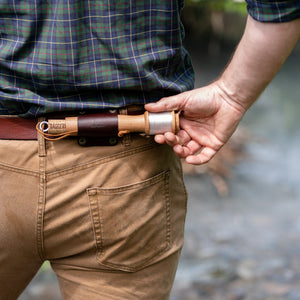Mushroom Foraging Guide
Mushroom foraging is growing in popularity across the nation, and it’s easy to see why. With the current pandemic, it has become increasingly important to find enjoyable activities that we can do while keeping a healthy distance from others.
Mushroom foraging is a naturally socially distant activity, keeps the mind and body active while spending time in nature, and, if you’re lucky, yields delicious mushrooms.
Foragers can find choice culinary mushrooms in nearly every region across the United States, save the dry, desert area of the Southwest. Specimens of morel, porcini, chanterelle, matsutake mushrooms, and even more can be found in the Pacific Northwest.
A great place to hunt is on the east side of the Cascade Mountains. The Midwest is known as a haven for morels. These highly-sought after ‘shrooms can be found, usually near freshly dead elm trees, in every state in the region. In fact, foraging is so popular in Missouri that the locals proudly refer to foraging season as “morel madness.”
Many other mushroom species can be found in the Midwest as well. The Northeast offers a variety of species too, some including penny bun mushrooms, hedgehog mushrooms, and, of course, morels.
Some species, like ramps, fiddlehead ferns, morels, and oyster mushrooms, can even be found in the deep South. From coast to coast, mushrooms and their foragers can be found in most places in the country.
Mushroom foraging does not require much in the way of equipment to find and pick mushrooms. However, there are a few key resources that are highly recommended.
Here’s what you’ll need:
- Mushroom foraging basket
- Pocket knife
- A knife is necessary to clean up the stems of mushrooms, cut them to check for worms, and cleanly extract them from the ground.
- A garden trowel
- Harvesting a complete specimen from the ground makes it easier to identify many species—specifically Boletes and Amanitas—and a knife can sometimes damage the base. For that reason, it’s helpful to carry a small trowel or a hand weeder to extract the whole mushroom.
- A cleaning tool
- Bring along a paint brush or soft-bristle toothbrush to clean the tops, gills, ridges, and pores of your mushrooms after you’ve picked them. The less dirt that goes into your mushroom foraging basket, the less cleaning your mushrooms will require later.
- A permit
- If you’re hunting on government land, a permit will likely be required. These permits are typically free and will allow foragers to collect a considerable amount of mushrooms; in some areas, that equates to two pounds per day.
- In some areas, certain rare mushrooms may require a special permit, such as matsutakes in the Pacific Northwest.
- Water and snacks
- Whenever you trek into the wilderness, whether you’re foraging in a forest or hiking on a mountain trail, be sure to bring along water. In order to stay properly hydrated, it is recommended to bring at least one liter of water for every hour you plan to spend outdoors.
- You are likely to work up an appetite while foraging, and it is not advisable to snack on raw mushrooms. Bring light-weight, high-protein food, like jerky or nuts, to keep you energized.

Additionally, make sure to invest in a detailed mushroom guide. The biggest fear most people have when they begin foraging is meeting an ill-fate by mistakenly sampling the wrong type of mushroom. That anxiety is reasonable, as there is a well-known adage among mushroom foragers: “You can eat any mushroom … once.”
According to the National Poison Data System, in the United States, three people per year suffer from mushroom-related deaths- making them rather rare. While extremely deadly mushrooms, like the famed death cap, do exist; others are not likely to lead to death, but certainly will cause illness.
Nearly 7,500 people annually suffer from poisoning due to either eating the wrong species or failing to prepare wild mushrooms correctly. The symptoms range in severity, from mild nausea to liver failure.
Some mushrooms that are considered safe to eat still need to be thoroughly cooked to destroy naturally occurring toxins. This is one reason wild mushrooms should never be consumed raw. Another reason is that cooking mushrooms unleashes their considerable nutritional value and allows them to be more easily digested.
Now that you can clearly see the importance of properly identifying mushrooms, make sure to invest in an appropriate mushroom guide. Do not rely solely on an app. Ideally, you’ll want to purchase a guidebook that addresses your specific geographical region. It is advised to procure a book that provides a broader overview of mushrooms as well, especially if you are interested in foraging while traveling.
Mushrooms Demystified by David Arora or Gary Lincoff’s The Complete Mushroom Hunter: An Illustrated Guide to Finding, Harvesting, and Enjoying Wild Mushrooms are both highly recommended to any mushroom forager.
Some general tips:
- The best time for mushroom foraging is after a heavy rain.
- When you find a mushroom, cut the fleshy top off about an inch from the base. This allows the mushroom to regenerate.
- Only pick mushrooms that you can positively identify. If you are unsure, take pictures to share with others to gain feedback and, hopefully, knowledge.
- Do not take more than you plan to eat.
- Make sure to enjoy being in nature, even if you don’t find any mushrooms.
- Most importantly, DO NOT consume any mushrooms unless you are totally, 100% certain that they are edible (i.e. not poisonous).



















